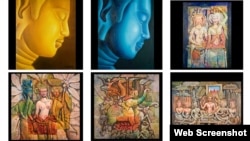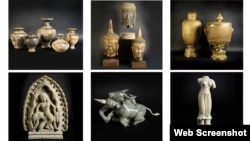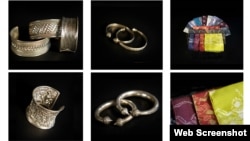When she was 11, Bonna Neang woke daily at first light to a Khmer Rouge tune broadcast over a public speaker in a hamlet in Cambodia’s rural Banteay Meanchey province.
“The bright, fresh red blood was spilled all over the towns and over the plains of Cambodia, our motherland. … ”
The child of a Phnom Penh family well-versed in classical Khmer music and appreciative of youngsters’ at-home dance performances, Bonna Neang Weinstein, now 53, still recalls the lyrics to “Build a Revolution.”
Today, the mother of three sons and stepmother of three daughters, owns a Philadelphia gallery, Khmer Art, which is dedicated to the revival of Cambodian work. She describes it as a portal to a culture the Khmer Rouge, who captured Phnom Penh on April 17, 1975, attempted to eradicate over the next four years.
Among the 1.7 million people who died in a population of 6 million were 90 percent of the nation’s artists, felled by revolutionaries with the motto “To keep you is no gain; to lose you is no loss.”
“The Khmer Rouge is a dark episode” in Cambodia’s history, Weinstein said. The regime also wiped out the educated, the skilled, the city dwellers and the intellectuals. She said she believes the revival of the arts allows Cambodians to reclaim their heritage because “the Khmer Rouge is not us … that’s not who we are.”
For the world
Ethnomusicologist Sam Sam-Ang, a MacArthur Foundation “genius” said “[Khmer] arts do not only belong to Cambodia, they belong to all human beings in the world.”
Today, there is evidence such as Prumsodun Ok’s Ted Talk on Khmer classical dance that Cambodia’s traditional cultural life is undergoing a robust renaissance after the Khmer Rouge suppression.
“Beauty is the most resistant thing,” Ok said in the October talk, which also discusses the intergenerational transfer of Post-Traumatic Stress Disorder, or PTSD, among Cambodians from Khmer Rouge survivors to their offspring. “Beauty is what connects people to time and place.”
As those connections strengthen, Khmer artists are taking the traditional into new areas.
“Cambodian art is rebuilding and that means both the traditional art, so people who do the classic paintings of Angkor Wat and carving and Buddhist images,” said anthropologist Judy Ledgerwood, adding there is “a growing body of art that combines traditional themes with modern ideas, and more recently, some very modern work, but still with a Cambodian theme and idea.”
Weinstein is one of the many Cambodians determined to use traditional arts, such as dance, music, carving and painting, to revive a rich culture. It is a point of pride.
From the ninth to the 14th century, Khmer culture flourished. Its lasting legacy, the Angkor Wat complex, at its full glory was about the size of Los Angeles. “Nonskilled, noneducated people cannot make that,” Weinstein said.
Well into the mid-20th century, the Angkor complex anchored a cultural life that was one of the most vibrant southeast Asia, attracting such people as the late Jacqueline Kennedy and inspiring creatives such as the late architect Vann Molyvann.
There was even a vibrant local rock ’n’ roll scene featuring the likes of Sinn Sisamouth and Ros Serey Sothea recalled today by the Cambodian Space Project.
Human expression
That Cambodia’s cosmopolitan heritage could not be eradicated by the Khmer Rouge dream of creating an agrarian utopia speaks not only to Cambodians’ resilience but to something that makes us all human.
“There is no culture without artistic expression,” said anthropologist Ledgerwood, who has been conducting research on Khmer culture since 1989.
Think of the cave paintings by early homo sapiens in France, Indonesia and Spain, and recent findings that even Neanderthals may have expressed themselves artistically.
“Human beings always look for ways to express themselves through textiles, painting, sculpture, music, dance, even in language itself in the way that we structure our speech,” Ledgerwood said.
Which is why authoritarian regimes like the Khmer Rouge target artists.
Joseph Melillo, who brought Bangsokol: A Requiem for Cambodia to New York’s Brooklyn Academy of Music (BAM) in December, says art “allows individual people to think freely and to feel emotionally. ... If you remove artists and intellectuals from your society, that means political power could dictate the style of life and the thinking of the people, because there is no ( group) in other parts of the society that are able to offer an alternative to what artists and intellectuals are articulating.”
Creating a role model
Cambodian composer Him Sophy, a Khmer Rouge survivor, built Bangsokol, which is named after a ceremony performed at Cambodian funerals, on Khmer traditional music enhanced by a Western orchestra and a Taiwanese chorus.
“Because of my pain during the Khmer Rouge that I cannot forget, I try to express my feelings, emotion and thoughts through the music I compose,” said Him Sophy, who lost two older brothers to the regime.
Sam Sam-Ang told VOA that “Bangsokol” represents “Cambodian pride. We created an international art production, and it is a role model for our next generations to show them that we are capable to do it like any other nations in the world.”
Cambodian Living Arts (CLA), a nonprofit group that works to support the revival of traditional art forms, commissioned Bangkosol.
Prim Phloeun, CLA’s executive director, told VOA that of the Khmer traditional musical instruments played in the performance, the ancient Khmer harp called a “pin,” attracts the most attention from audiences, in part because it “disappeared” nearly 900 years ago.
Khmer musician Keo Sonan Kavei, and French ethnomusicologist Patrick Kersalé joined Him Sophy to build a pin in 2014, using inscriptions and sculptures on Angkor Wat and Sambo Prey Kok temples as their blueprints.
Sngoun Kavei Sereyroth, one of the two harpists who performed in Bangsokol, is also Him Sophy’s first harp student.
“I play harp because five or six generations of my family are artists. I have art in my blood,” said Sngoun Kavei Sereyroth, who started to play the pin when she was 14 years old.
“We contribute to the rebirth of Khmer musical instruments and prevent them from disappearing because we have shown those instruments to the young generations,” Him Sophy added.
Masters of the arts
Not all artists and artisans use the bas reliefs of Angkor Wat for instructions.
Weinstein, who left Cambodia in 1979 when she was 14, has been able to use family connections to find masters who survived the Khmer Rouge.
“During four years under the Khmer Rouge, people say Khmer arts were dying, but that’s not true,” Weinstein said. “For me, I think our Khmer arts were only dormant.”
The late Kikuo Morimoto, a Kyoto kimono painter and self-described silk fanatic, traveled throughout Cambodia in 1995, “asking from village to village if silk weaving still occurred,” according to the Institute of Khmer Traditional Textiles (IKTT).
Morimoto found a “very few old grandmothers left with the knowledge and skill to produce fine silk” and persuaded them to forgo chemical dyes for the plant-based dyes they no longer used. Today, the IKTT trains apprentices who spend a decade learning the spinning, dying and weaving techniques to become master artisans.
“My father was a government officer and an artist and culture lover,” said Weinstein, who returned to Cambodia for the first time in the early 1990s. “His circle was interconnected. I knew how to ask, and how to keep in touch with that group. One friend leads to another friend.”
Weinstein found a wood-carving master who was released from a Khmer Rouge labor camp when the Vietnamese invaded Cambodia in 1979. He salvaged “as much wood as possible, from temples, big houses, pagodas that the Khmer Rouge had ordered demolished … to save the past, use it in the present and present it to the future.”
The wood carving master took on apprentices and, using a book of old drawings, taught them how to carve “using the old ways … and by practice,” Weinstein said, adding that she saw the same process repeated with coppersmiths, painters and other craftspeople.
“The copper pieces we commissioned in Cambodia are hand-chiseled, hand-hammered” in a foundry with an open fire. “There’s no modern technology at all.”
Tapping into these traditions, connects Cambodians, Weinstein said.
“The arts, the performing arts, I don’t know how we could show our identity without the performing arts, the visual arts,” she added.
Ethnomusicologist Sam Sam-Ang suggests the revival of Cambodian arts has an importance that transcends the country, saying if these arts are lost, “the world also loses something, and we lose more because we are the owners of our arts.”











